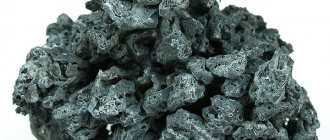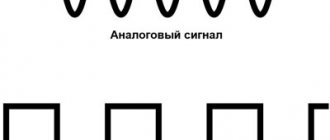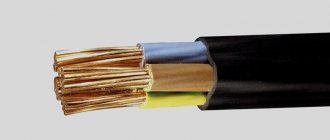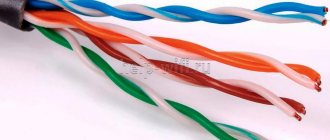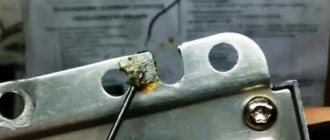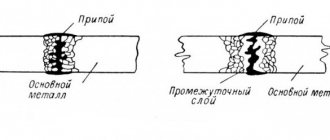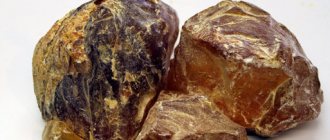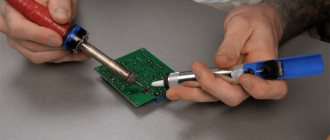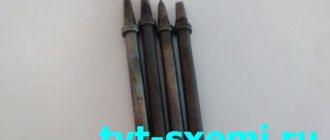What is solder
Solder is a mixture of alloys used to join parts. The process of joining parts with solder is called soldering.
A good soldering result is a clean and shiny contact. If the contact has cracks, then this is the result of cold soldering. Cold soldering can be caused not only by non-compliance with the temperature, but also by the composition of the solder. If there is a lot of slag in the solder, it will negatively affect the reliability of the connection.
Different solders are used for different tasks.
Basic properties
Solder wettability
This term means the adhesion of molecules of a liquid melt to a solid surface, the degree of which determines the fluidity of soldering . For good soldering, liquid solder qualitatively wets the surface where soldering occurs, and its boundary forms an acute angle.
Dried flux can only be removed by mechanical cleaning, because additional alloy has appeared. If a drop of molten substance forms an obtuse angle with the surface, then this indicates unsatisfactory wetting quality, which is counteracted by dirt, grease stains or a metal oxide film.
Options for wettability of soldering surfaces with molten flux.
Melting temperature
The main criterion for choosing high-quality alloys is that they must come into a liquid state earlier than the structures being joined , and the melting point of the solder differs significantly from that of another type, for example, those containing lead impurities.
The presence of different impurities affects the ability to melt at the same temperature, for example, POS-40 melts when it reaches 238 0 C, but there are refractory solders and special devices are used for their melting.
General division
Solders are divided into two groups. These are soft and hard.
Soft ones have a melting point of up to 300 °C. Radio components are soldered with such solders, and these include tin-lead and lead-free materials. The main working tools with such materials are soldering irons up to 50 W and soldering guns.
Solids melt over 300 °C. These are durable materials with a high tensile strength compared to soft ones.
These include copper-zinc and silver. Such solders can only be worked with powerful soldering irons, blowtorches or torches.
This article will describe in detail the soft solders that are used for radio components and equipment repair.
Solder classification
The class of solder depends on the melting temperature:
- Soft solder is achieved by melting up to four hundred degrees Celsius.
- Brazing solder is achieved by melting above five hundred degrees Celsius.
- Semi-solid solder is achieved by melting anywhere from molten tin to four hundred degrees Celsius.
Solders of the soft and semi-hard classes are strong at tensile strength from fifty to seventy Megapascals; they are intended for soldering conductive parts of machines. They are made by using a soldering iron or by dipping the parts to be soldered into liquid solder.
Hard solder is strong up to five hundred Megapascals, used as the number one strength category solder for soldering conductive parts with high heating and parts with major mechanical load. This type of solder is produced using electrodes made of copper or graphite. Small parts are soldered using an autogen.
Read also: What are anchors in construction
The second important component of soldering
As with the choice of soldering flux, solder also affects the result, durability and reliability of contact.
What does quality depend on and why is it important?
The quality of solder depends on the amount of impurities and slags. If the manufacturer violates the manufacturing technology, the solder will be of unsatisfactory quality. For example, when producing low-cost solder, the manufacturer may add impurities to increase the mass of the product. After soldering with such solder, microcracks remain on the contact, which could not melt with the tin. Such contact is a priori unreliable and does not meet soldering standards. Over time, the contact will be completely destroyed. Therefore, it is so important to read reviews about the manufacturer and its products, especially for beginners. Beginners cannot immediately distinguish good solder from bad due to insufficient work experience. Even if you do soldering according to the rules, nothing good will come out with bad solder.
Contact degradation process
Let's look at a few examples schematically. A good contact shines and has no cracks or streaks.
And if the contact is poorly soldered or the solder is of poor quality, small stains appear on it immediately after soldering. The photo below shows solder with a high content of impurities.
These are microcracks that begin to oxidize over time and increase contact resistance.
As a result, the contact is broken and visible cracks form across the entire surface.
Contact with streaks does not always mean a sign of poor soldering or solder. If there are small stains on the contact, then this is within normal limits. It’s another matter when there are such stains on the entire contact surface.
Basic properties of the alloy
When considering the temperature at which tin melts for soldering, it should be borne in mind that not only this indicator is taken into account. The materials used for soldering are characterized by the following properties:
- Wettability. To ensure a high-quality connection, the alloy used must have a high wettability index. This concept means increasing the reliability of the connection between molecules of solid materials. At a high index under consideration, the molten substance disperses over the surface, filling all the cavities.
- Electrical conductivity. In most cases, soldering alloys are used to produce various microcircuits. With high electrical conductivity, the resulting connection does not create additional resistance during operation. If the conductivity is too low or the resistance is too high, the contacts created begin to heat up.
- Melting temperature. The main criterion when choosing an alloy is that it must melt at a much lower temperature than the metals being joined. In this case, the melting temperature of tin solder will differ significantly from the corresponding indicator of other solder. The same alloy can melt at different temperatures, it all depends on the chemical composition. The presence of impurities causes an increase or decrease in fusibility. The melting point of POS-40 solder is 238 degrees Celsius. There are also refractory solders, which require a special device to heat.
Read also: DIY winding machine with tension
It is important to consider the temperature at which tin-lead or other solder melts. This is due to the fact that when the base material is heated to critical values, the structure is reconstructed and it changes its basic performance qualities.
What solders are used for soldering radio components?
The main types of solders used are PIC (tin-lead solder) and lead-free solders. POS has a melting point of approximately 180 to 230 °C. This alloy is well suited for soldering parts, but on an industrial scale, lead-free solders are used, which have a slightly higher melting point from 180 to 250 °C. Lead-free solders do not contain lead, they emit fewer emissions and, most importantly, they do not contain lead. Lead vapor is highly polluting to the environment, so lead-free solders are used during the production of printed circuit boards. However, lead-free solders not only melt at higher temperatures (due to the absence of lead), but they also leave a “tin whisker.” These whiskers can cause a short circuit after soldering SMD contacts. They are hardly distinguishable without a microscope, and their thickness is less than 1 micron.
Lead-free solders are also used in BGA soldering as solder balls.
POS solders are suitable for radio amateurs. These are easier to solder, and they won’t cause much harm if you don’t solder on an industrial scale. Moreover, lead-free solders do not reach the level of PIC solders in terms of wettability and quality of contact after soldering.
Classification by type
Solders are produced:
- With flux;
- No flux.
It is convenient to use solders with flux on a soldering iron, since the flux helps to be distributed over the soldering iron tip. Also, solders with flux are very soft, and they can be rolled into several rods.
According to condition
Solders are produced mainly in the form of rods with a cross-section from 0.1 to 2 mm. This is the hard type. There are also solder pastes. It is a mixture of microscopic beads in flux. Used for BGA soldering.
Solder paste is mainly used for soldering microcircuits and connector pads. It is irrational to use paste for soldering wires, since the price of paste is much higher than regular solder.
Low temperature alloys
In addition to soft solders, there is also a subtype of them. These are low-temperature alloys of Rose and Wood.
Such alloys are usually used for safe soldering of parts. These alloys are not recommended for soldering parts onto a board due to their low mechanical strength and melting point (from 60 to 100 °C)
Which ones are there?
What is solder and how to choose it correctly - in practice they can be soft or hard . Installation of any radio-electronic equipment occurs using low-fusible options.
Components of unknown origin differ in the following characteristics:
- The rich shine of the cut indicates a high presence of tin.
- The predominance of lead guarantees the substance a dull gray color and a matte surface.
- With an increased lead content, the product becomes plastic; for example, a wire with a cross-section of 6 mm is bent by hand without visible effort.
Sometimes, for high-quality soldering, a ready-made mixture is used - this is solder in the form of a wire, and the flux is sealed inside. Manufacturers produce similar substances with flux tolerance within 1-3% of the total weight, which has a beneficial effect on the soldering process and increases labor productivity, since there is no need to constantly dip the soldering iron tip into a jar of flux.
Based on consistency, they are available in two types: soft or hard solder, and based on the melting point, ordinary and refractory types are distinguished.
Which solder to choose
For radio amateurs, a POS with flux (rosin) in the form of a rod from 0.2 mm to 1 mm is suitable. This type of solder is easiest to use on a soldering iron due to the presence of rosin. And the small cross-section of the rod allows you to accurately dose the required amount of solder. If you need to take more solder with your soldering iron, then just twist several rods together, and from 1 mm of rod we get 2 mm.
Also pay attention to the mass of solder. It should not differ from that indicated on the packaging. If the mass is different, then most likely the coil of solder was rewound, and you received a low-quality product.
If you order from online stores such as Aliexpress, ignore reviews such as “received, 5 points” and the like.
Read reviews and check the product you received.
Four secrets of soldering
In order to solder well and correctly, one tool is not enough. You also need to know some secrets that would allow you to master the soldering technique to perfection. It’s probably worth revealing a few of these secrets.
So, the first secret is to correctly use solder and flux for soldering. The second important secret of soldering is maintaining the cleanliness of the tip and the soldering iron itself and, of course, its heating. There are many ways to clean a sting. Use one of them and then your work will go just fine.
The third secret is also important when soldering: the cleanliness of the objects being soldered. The fourth rule, which any master needs to understand, is simple but necessary: connect the wires correctly when soldering and do a good warm-up of the places where the parts will be soldered at a certain melting temperature.
And, of course, when working with such equipment, you should always take precautions. So, it is necessary to solder not at one point, but try to do it at some distance from each other. Do not twist the ends of parts around the conductor at melting temperature.
It is always worth remembering that when soldering, even at the lowest melting point, tin and lead vapors are released. They are very dangerous and harmful to the human body. Therefore, you should never lean over the place where soldering occurs, no matter what the melting temperature is.
After all, no matter what the melting temperature of the solder, the fumes will still be harmful and will cause irreversible harm to the human body. If you decide to solder in the summer, then do it either in an open space, or, if possible, near an open window. The main rule for such soldering is to ventilate the room well. And when the work is finished, you will also need to thoroughly wash your hands using soap.
Electronics for everyone
Fluxes During the soldering process, due to heating, the parts oxidize and the solder ceases to wet them. To prevent this from happening, fluxes are used - substances that dissolve the oxide film and promote soldering. By the way, if anyone doesn’t know, the process of coating one metal with another is called tinning. Am I saying banal things? Well, this is an educational program! Rosin
To prevent this from happening, fluxes are used - substances that dissolve the oxide film and promote soldering. By the way, if anyone doesn’t know, the process of coating one metal with another is called tinning. Am I saying banal things? Well, this is an educational program! Rosin
| Rosin - a classic of the genre |
The simplest and most popular flux. This is ordinary purified pine resin. When soldering, first take a little solder onto the tip, then poke it into the rosin to get resin onto the tip, and then quickly solder before the resin evaporates. The method is not very convenient, so they often do it differently. Take ordinary ethyl (medicinal) alcohol and dissolve crushed rosin in it until it dissolves. Afterwards, this solution is applied with a brush to the parts to be soldered and soldered. The activity of rosin is not high, so sometimes nothing works out - the details are not tinned, but rosin has one huge advantage, which sometimes overcomes all its shortcomings. Rosin is absolutely passive. That is, it does not need to be removed from the soldering site, since it does not oxidize or reduce metals, while being an excellent dielectric. This is why I try to make the most critical solderings with alcohol-rosin flux.
LTI-120
| LTI-120 |
| Glycerol-hydrazine |
| Rosin-gel. Super thing |
| F-34A - chemical weapon of mass destruction. |
Flux palette  |
One of my favorite fluxes. It is a red liquid that contains rosin and a number of additives. Solder it in the same way as regular alcohol-rosin flux - spread it on the parts with a brush and solder. But there is one trick. In the original version, LTI-120 is a liquid infection, spreads on a thin layer and dries instantly, in general it is not very convenient to use. I figured out how to overcome this. I made myself a palette of fluxes - I glued a bunch of bottle caps onto a small batch, poured different fluxes into them and glued this thing onto a coil of solder. It turned out very convenient and compact. So, after pouring LTI-120 into the cap, I let it sit for a couple of days. During this time, it will dry out and thicken to the state of liquid honey. Now it’s convenient to spread it with a sharp toothpick exactly where you need it. And if it thickens too much, then either I’ll drop a little alcohol in there, or I’ll add a little more fresh flux and stir it. The manufacturer claims that LTI-120 does not need to be washed off. In principle, this seems to be the case, he is not active. But the additives in it confuse me, so I always wash it off. It is washed off with a wide brush dipped in alcohol. Or just use a brush under running tap water. There is nothing wrong with washing the finished board with water, the main thing is to dry it well afterwards.
Rosin gel Excellent stuff. It appeared in radio stores not long ago and has already earned my love and respect. It is a thick brown paste based on rosin, sold in syringes. It spreads perfectly directly where it is needed and does not leave residue on the soldering iron, like LTI-120. Easily washed off with water or alcohol, in general, rulez!
Glycerol-hydrazine. Killer active flux, which is easily washed off with water, does not leave dirty sticky marks or oxides. But it needs to be washed off. Rinse thoroughly. Otherwise, in a couple of years it can corrode the board tracks or its remains will become conductive and terrible leaks will occur along the surface of the board between the tracks, which will have an extremely negative impact on the operation of the circuit. I'm also not sure about the safety of its vapors. You can use it once or twice, but I don’t like using it all the time. But overall, this is an awesome flux, and it’s a pleasure to solder with it.
Glycerin-Salicylic flux . He is FSGL. Honestly, I have no idea where this crap even comes from. I’ve had a jar of this flux since childhood (which is actually why I almost never soldered with rosin) - my dad stole it from a defense plant. I have never seen it on sale for free. It burns as vigorously as Glycerin-hydrazine, but does not contain any impurities that are questionable from a toxic point of view. It contains 90% glycerin, 5% salicylic acid, 5% water. Should I buy some salicylic acid at the pharmacy and apply it myself? This is such a crazy recipe. One drawback - you need to wash it off, it is active. But it washes off easily with water.
F-34A Hellish acid mixture. When soldered, it produces a terrible, caustic exhaust that poisoned half of our laboratory. You can solder this crap only in a gas mask and with a powerful hood, but this crap solders everything, something that other fluxes could never even dream of. This slurry prevents ingress - rust, oxides, steel, coatings, even aluminum can be soldered. So if you have to solder to a rusty nail, then drop this crap, hold your breath and LOOP!
Imported no-clean fluxes. To be honest, I haven't used them. They say they are cool, but IMHO it’s not rational to solder them just like that - they are too expensive, and they don’t sell them in our city, but it’s a shame for me to order them. Rather, they are for professional use, such as repairing cell phones or soldering BGA cases (this is when the legs are in the form of an array of balls under the microcircuit body). If you are interested, look for information on cell phone repair forums, they know everything about this matter.
Hemp-based Dutch flux I have no idea who makes it or where they sell it, but I know for sure that it exists! I was especially convinced of this after poking around in the product diagrams of the company where I previously worked. The developers are clearly sold on them. Since I have never seen such stoned circuit solutions.
Soldering iron in hand and go!!! I told you about fluxes, now, actually, about the soldering process. This is not a tricky thing. To begin with, it is advisable to tin the parts. You moisten them with flux, pick up a little bit of solder with the soldering iron tip and spread it over the surface. There is no need to rush; the parts should be covered with an even, thin, shiny layer. There is no need to tin the leads of microcircuits and radio components - they are already tinned at the factory.
The solder should be liquid, like water. If it is lumpy, with pronounced graininess and matte, then there are two reasons - the temperature of the soldering iron is incorrect , or the solder is low-grade crap . If the soldering iron is too cold, the solder will be on the verge of solid and liquid, will be viscous and will not wet. If the soldering iron is overheated, the solder will instantly become covered with a gray film of oxide and will also tin tin disgustingly. The ideal temperature of a soldering iron when soldering with POS-40 solder ( 60/40 Alloy ), in my opinion, is about 240-300 degrees. For ST-96, it is enough to set the regulator by 2/3 in the direction of increase.
If you solder a printed circuit board, then the tracks also need to be tinned. But this must be done carefully. Textolite that is sold in the vastness of the Motherland often also turns out to be rare shit and when heated, the foil falls off instantly. Therefore, you cannot heat the board for a long time - the tracks will fall off. Usually I just thoroughly lubricate all the tracks with LTI-120 and quickly run a flat soldering iron tip with a drop of solder along each one. As a result, I have perfectly tinned tracks with an almost mirror-like surface.
There is a popular method for quickly tinning large boards:
| Solder Removal Braid |
| My tin |
Take a braid to remove solder, this is a copper sponge, sold in rolls of 30 rubles per meter. If you don’t find it, you can pick out the braided shielding from a thick television coaxial cable - the same crap, just more fuss. The board is properly lubricated with flux, the braid is properly impregnated with solder and is also poured with flux. Then this crap is messed around with a soldering iron on the surface of the board. To prevent the braid fibers from sticking to the tracks, it is better to take a larger and more massive soldering iron.
This is how I completely improved the method. I took an old powerful 60W soldering iron, wrapped the tip in this braid, impregnated it with Rose alloy and now puddle the board in one motion. Why Rose? And it’s easier for them to tinker; when the soldering iron touches the board it cools down sharply, because... gives off heat. If the braid is moistened with ordinary solder, then it is immediately welded with separate fibers to the board, and the Rose alloy is lightweight and does not stick.
Soldering transistors, diodes and microcircuits. Here I would like to draw special attention. The fact is that semiconductors are destroyed by too high a temperature , so there is a risk of burning the microcircuit due to overheating. To prevent this from happening, it is advisable to set the soldering iron to 230 degrees or so . This is a completely tolerable temperature that the microcircuit can withstand for quite a long time. You can solder and take your time. Conventional, non-adjustable soldering irons have a tip temperature of about 350-400 degrees , so you need to solder quickly, with one touch. No longer than a second on each leg and take at least a 10-15 second break before starting to solder the other leg. You can also hold the leg with metal tweezers - it will serve as a heat sink.
Soldering wires It is better to tin the ends separately before soldering, and if the wire is soldered to a printed circuit board, then it is very advisable to drill a hole in the board, bring it in from the other side and only then solder it. In this case, the risk of tearing off the droshky when tugging on the wire is reduced to zero.
Soldering with solder wire. This is how microcircuits are usually soldered. They grab it diagonally by the outer legs, lubricate everything with flux, and then, holding a soldering iron with one hand and a thin wire of solder with the other, quickly solder all the legs.
Soldering wires in varnish insulation Any winding wire, like those that are wound around a transformer, is covered with a thin layer of varnish. To solder to it, this layer of varnish needs to be peeled off. How to do it? If the wire is thick, you can burn it a little with the fire of a lighter, the varnish will burn, and the carbon deposits can be cleaned off with rough cardboard. If the wire is thin, then either carefully scrape it with a scalpel, holding the scalpel strictly perpendicular to the wire, or take an aspirin tablet and firmly press and rub the hot tip of the soldering iron along the wire on the aspirin. When heated, the aspirin will release a substance that will eat the varnish insulation and clean the wire. It will really stink
To solder to it, this layer of varnish needs to be peeled off. How to do it? If the wire is thick, you can burn it a little with the fire of a lighter, the varnish will burn, and the carbon deposits can be cleaned off with rough cardboard. If the wire is thin, then either carefully scrape it with a scalpel, holding the scalpel strictly perpendicular to the wire, or take an aspirin tablet and firmly press and rub the hot tip of the soldering iron along the wire on the aspirin. When heated, the aspirin will release a substance that will eat the varnish insulation and clean the wire. It will really stink
Third hand
| Convenient holder. |
I recommend getting a grip like this. A damn convenient thing, it allows you to hold some Cthulhu while soldering, the ends do not dangle from side to side. By the way, beware of spring-loaded conductors! When soldering, it can jump off and throw a drop of solder in your face, I can’t remember how many times this has flown into my face, but it could have even hit my eye! So follow safety precautions!
The sponge tip of the soldering iron gradually becomes dirty and becomes covered with soot. This is normal, usually the flux is to blame, the same LTI-120 burns, God forbid. You can use a special sponge to clean the soldering iron. This yellow stuff comes with soldering iron stands. It must be moistened with water and squeezed out, leaving it damp. By the way, the sponge dries constantly, so that it doesn’t get wet every time; you can soak it in regular medical glycerin. Then it won't dry out at all! Damn convenient! If you don’t have a sponge, then take a cotton cloth, put it in an iron tray and also soak it in water or glycerin. Our installers kept an ordinary waffle towel on the table and wiped the soldering iron on it.
By the way, about safety precautions.
- First, arrange everything so that it is convenient.
- Keep an eye on power cords. The soldering iron loves to burn through its own wire . He's just manic. And this risks, at best, repairing the wire, at worst, a short circuit and fire.
- Do not leave the soldering iron turned on, even for a short time. The “ Gone - turned off ” rule must be strictly followed.
- Rule two - the soldering iron must be either in your hand or on its reliable stand . And no other way! Under no circumstances should you put it on the table or on the first thing that comes along on the table. The cord will drag him away in a moment.
- Don't forget about exhaust hood and ventilation . If you solder, then at least open the window, ventilate the room, or better yet, put a fan (at least 80mm from the computer) or an extractor hood on the table.
It's better to see once than to read a hundred times: No problem! At your service are a bunch of videos from You Tube for the request “solder”. You'll see how the professionals do it. Watch and learn!
